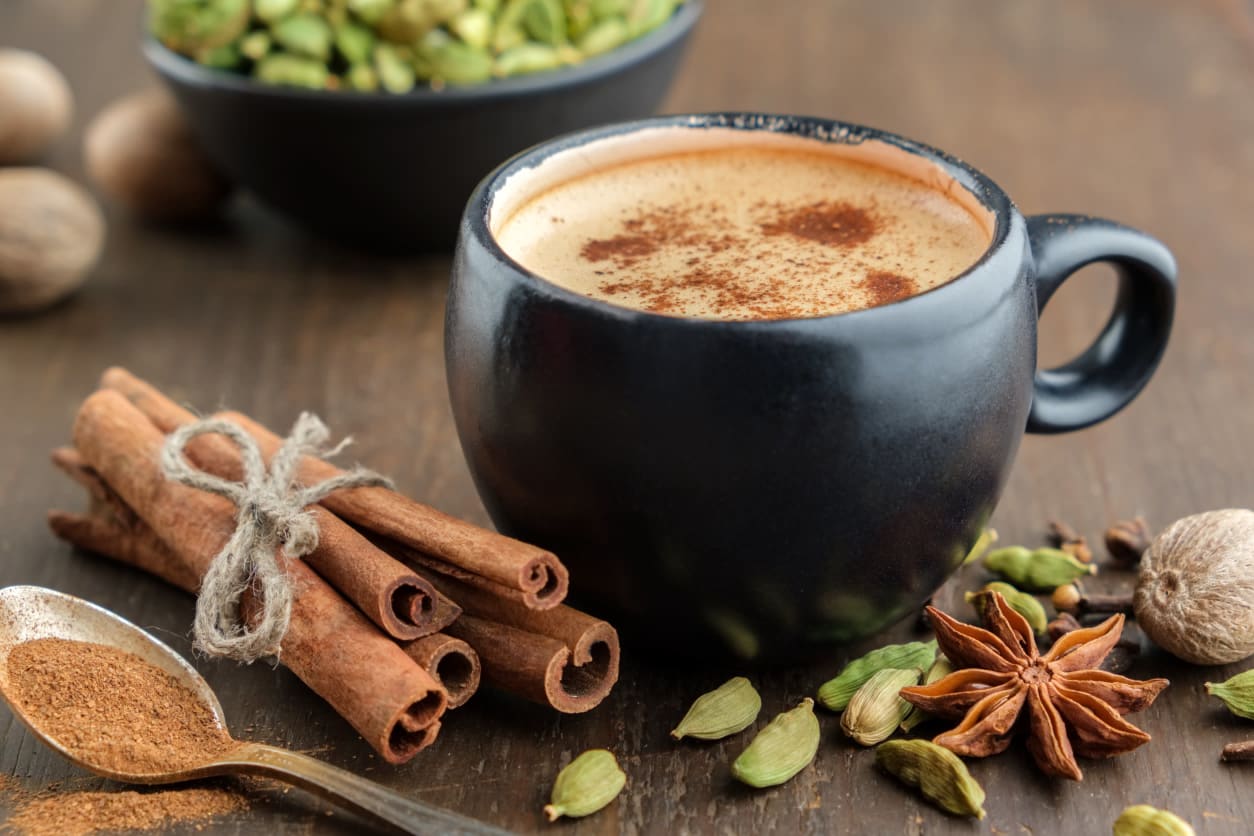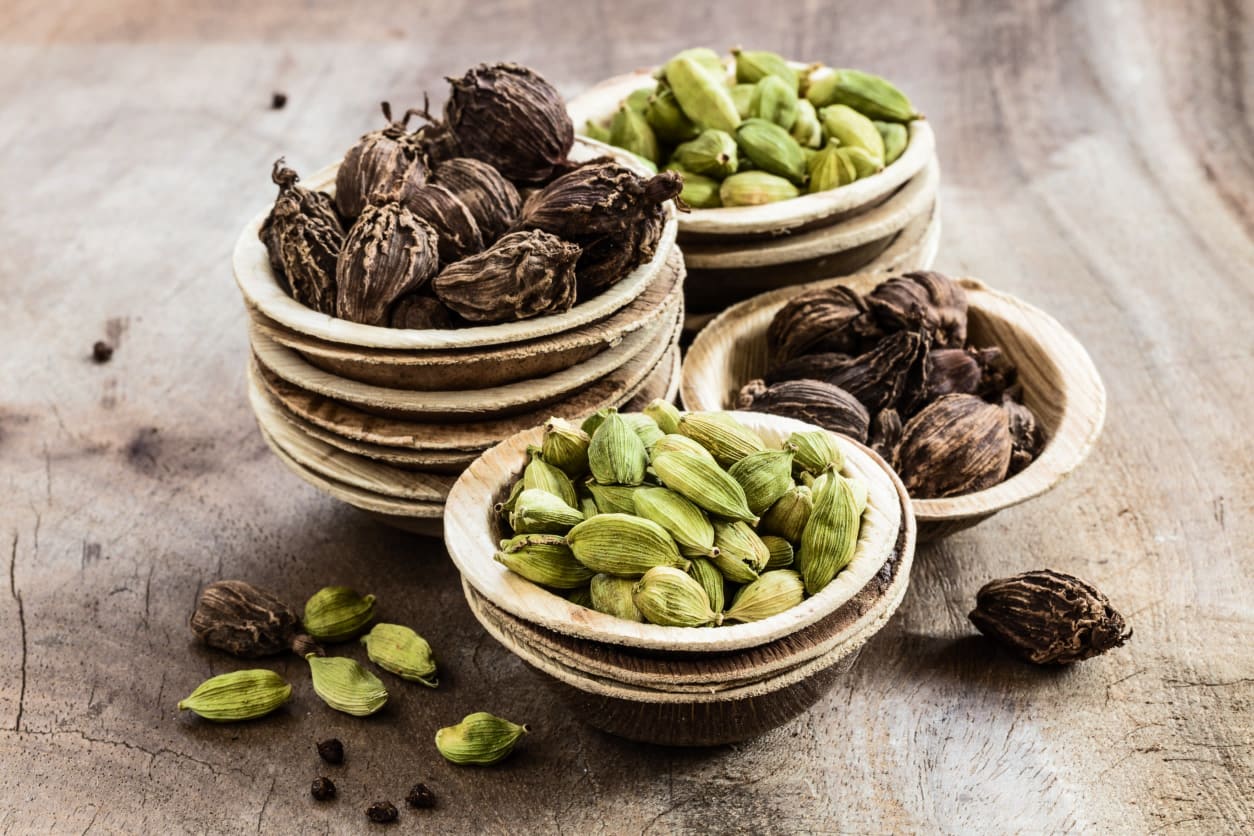From the flavour to the health benefits, there are plenty of reasons to spice up your cooking with cardamom – the ‘queen of spice.
1. Around the world
With its distinct fragrance, cardamom is integral to Indian cuisine, and a key ingredient in both garam masala and chai tea.
It also imparts a delicate floral spice to Middle-Eastern dishes that combine pomegranate, pistachio and rosewater, and lends a bitter-sweet flavour to cardamom coffee.
In Scandinavia, it’s used in baking, combining deliciously with pistachio and cinnamon.

Frothy ayurvedic masala chai tea
2. So many benefits
In some traditional medicine, cardamom is used to support respiratory, digestive, cardiac, kidney and dental health conditions, and cataracts.
Cardamom is also antibacterial.
A recent review suggested that compounds from cardamom may be beneficial for symptoms of modern-day diseases such as metabolic syndrome, including poor glucose control, insulin resistance, high blood pressure, inflammation, abdominal obesity, diabetes and heart disease.
3. Antioxidants and bioactivity
Cardamom has high levels of antioxidants that are associated with reducing the damaging effects of oxidative stress and chronic inflammation, and also helping to lower blood pressure.
Key to cardamom’s health benefits is its pungent aroma and flavours, which get released from bioactive compounds like quercetin, and oils such as cineole.
The oils become active and release aromas when molecules are disrupted by grinding, or from heat when cooking.
4. Pod magic
Cardamom pods are the fruit of a flowering plant (Zingiberaceae), a relative of ginger. It combines beautifully with ginger, adding fragrance and warmth to foods and drinks.
Pods contain up to 20 small dark seeds, which are best ground immediately before use to protect and release their compounds.
The outer husk of the pod contains 10% of essential oils and the inner seeds contain 90%, which makes the seeds much more potent when cooking.
Save empty pod-husks and for a mild flavour (e.g. in sauces or rice), wrap them in a muslin cloth while cooking and remove before serving.
For a stronger flavour, grind the seeds and pod-husks together to maximise the oils.
Although widely available as pods, cardamom can also be bought pre-ground into a powder.

5. Choose your colour
Cardamom has two main varieties: green and black.
Green, the most readily available, is versatile and suitable for both savoury and sweet foods, as a bitter-sweet warm spice with a mint and citrus flavour.
It combines well with any of the accent notes (lemon or mint).
A bleached version of green is milder, used mainly in Scandinavian baking.
Black cardamom adds a smoky, minty spice, which works best in savoury dishes.
6. All about the grind
Cardamom has two main varieties: green and black.
Green, the most readily available, is versatile and suitable for both savoury and sweet foods, as a bitter-sweet warm spice with a mint and citrus flavour.
It combines well with any of the accent notes (lemon or mint).
A bleached version of green is milder, used mainly in Scandinavian baking.
Black cardamom adds a smoky, minty spice, which works best in savoury dishes.

Swedish cardamom buns
7. So much potential
Cardamom can be on-hand all year round to flavour rice, curries, soups, marinades, drinks, breads, cakes, custards, ice-creams and fruit salads.
It can help sweeten drinks and reduce the need for added sugar.
Freshen up summer entertaining with mango lassi, made with your choice of milk (or yoghurt) and cardamom, and frozen in ice cube trays with cocktail sticks for tasty bite-size summer coolers that you can hold.
For a chilled summer salad, mix watermelon cubes and sliced strawberries sprinkled with coarsely-ground cardamom, drench with rosewater and mint leaves on a bed of baby salad leaves, and serve with hummus topped with pomegranate seeds.
Unwind with a cardamom tea. Use three to four split pods per cup of water and allow the seeds to infuse in boiling water until the pods soften and bloat, releasing the seeds and minty-spiced aroma.
Depending on preference, add cinnamon, ginger, black pepper and lemon. Save the seeds to use later as a natural breath-freshener.
Enjoyed this article?
Learn how to tackle tofu
For articles and recipes subscribe to Optimum Nutrition
Discover our courses in nutrition






